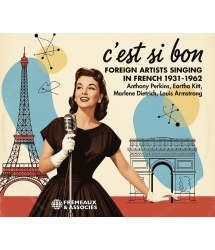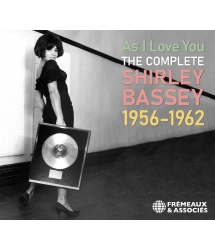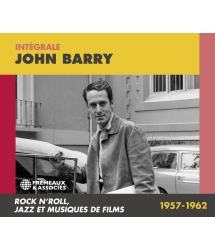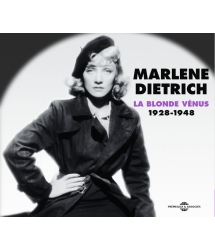- Our Catalog
- Philosophy
- Philosophers of the 20th century and today
- History of Philosophy (PUF)
- Counter-History and Brief Encyclopedia by Michel Onfray
- The philosophical work explained by Luc Ferry
- Ancient thought
- Thinkers of yesterday as seen by the philosophers of today
- Historical philosophical texts interpreted by great actors
- History
- Books (in French)
- Social science
- Historical words
- Audiobooks & Literature
- Our Catalog
- Jazz
- Blues
- Rock - Country - Cajun
- French song
- World music
- Africa
- France
- Québec / Canada
- Hawaï
- West Indies
- Caribbean
- Cuba & Afro-cubain
- Mexico
- South America
- Tango
- Brazil
- Tzigane / Gypsy
- Fado / Portugal
- Flamenco / Spain
- Yiddish / Israel
- China
- Tibet / Nepal
- Asia
- Indian Ocean / Madagascar
- Japan
- Indonesia
- Oceania
- India
- Bangladesh
- USSR / Communist songs
- World music / Miscellaneous
- Classical music
- Composers - Movie Soundtracks
- Sounds of nature
- Our Catalog
- Youth
- Philosophy
- News
- How to order ?
- Receive the catalog
- Manifesto
- Dictionnary











- Our Catalog
- Philosophy
- Philosophers of the 20th century and today
- History of Philosophy (PUF)
- Counter-History and Brief Encyclopedia by Michel Onfray
- The philosophical work explained by Luc Ferry
- Ancient thought
- Thinkers of yesterday as seen by the philosophers of today
- Historical philosophical texts interpreted by great actors
- History
- Books (in French)
- Social science
- Historical words
- Audiobooks & Literature
- Our Catalog
- Jazz
- Blues
- Rock - Country - Cajun
- French song
- World music
- Africa
- France
- Québec / Canada
- Hawaï
- West Indies
- Caribbean
- Cuba & Afro-cubain
- Mexico
- South America
- Tango
- Brazil
- Tzigane / Gypsy
- Fado / Portugal
- Flamenco / Spain
- Yiddish / Israel
- China
- Tibet / Nepal
- Asia
- Indian Ocean / Madagascar
- Japan
- Indonesia
- Oceania
- India
- Bangladesh
- USSR / Communist songs
- World music / Miscellaneous
- Classical music
- Composers - Movie Soundtracks
- Sounds of nature
- Our Catalog
- Youth
- Philosophy
- News
- How to order ?
- Receive the catalog
- Manifesto
- Dictionnary
1957-1960
DARIO MORENO
Ref.: FA5759
EAN : 3561302575926
Label : Frémeaux & Associés
Total duration of the pack : 1 hours 8 minutes
Nbre. CD : 1
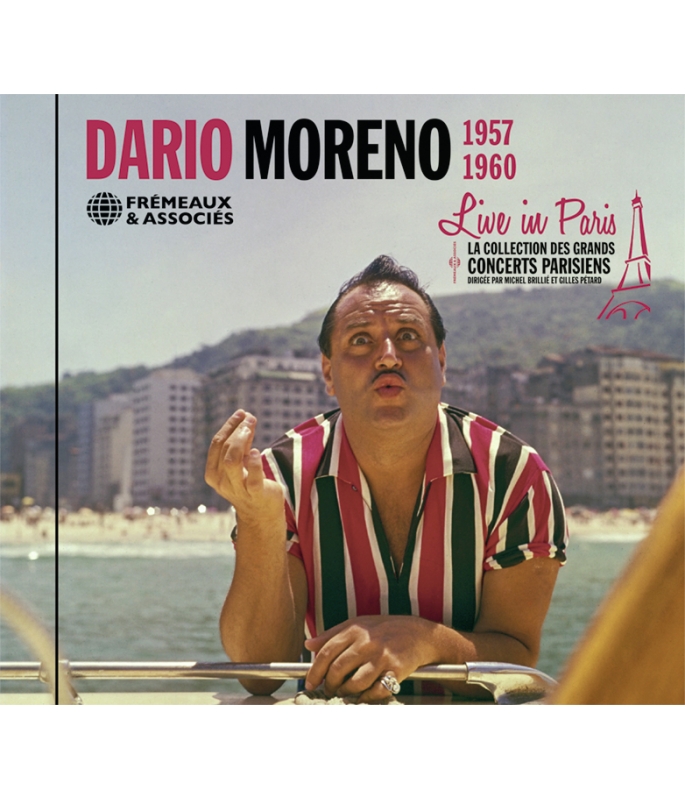
1957-1960
1957-1960
Who but Dario Moreno could have suc ceeded so well in France by incarnating the Golden Age of operetta and Latin rhythms? He had Turkish and Mexican origins, and he was an artist of delicate sincerity — as well as being a wonderful showman, with an unrivalled sense of humour that made everyone love him. The songs he left us have come down through the ages to form part of our national heritage. This album brings together some of the singer’s greatest moments in concert between 1957 and 1960, when he was at the peak of his fame. Patrick FRÉMEAUX
The Live in Paris collection by Michel Brillié allows listeners to hear previously-unreleased recordings (made at concerts and private- or radio-sessions) by the great 20th stars in jazz, rock & roll and song. These “live” takes, and the artists’ rapport with their audiences, gives these performances an additional soul and sensibility in counterpoint to the rigorous demands of studio recordings. Particular care was taken when restoring the sound of these tapes in order to meet CD standards while preserving the original colours of the period. Patrick FRÉMEAUX & Gilles PÉTARD
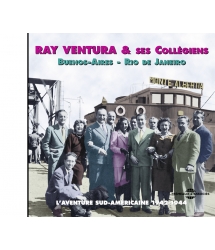
L'AVENTURE SUD AMERICAINE 1942 - 1944
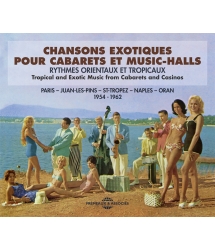
RYTHMES ORIENTAUX ET TROPICAUX
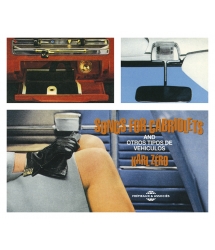
AND OTROS TIPOS DE VEICULOS



-
PisteTitleMain artistAutorDurationRegistered in
-
1MiguelitoDario MorenoGuy Magenta00:03:581957
-
2MarianneDario MorenoJacque Larue00:02:581957
-
3Quand elle danseDario MorenoRoger Lucchesi00:03:091957
-
4Personne au mondeDario MorenoFernand Bonifay00:02:061957
-
5Pizzicato de SylviaDario MorenoLéo Delibes00:01:401958
-
6Corps à corpsDario MorenoMaria Veldi00:02:371958
-
7Adios amigosDario MorenoGuy Magenta00:02:161958
-
8Lisboa antiguaDario MorenoJose Galhardo00:01:561958
-
9C'est l'amoreDario MorenoLouis Poterat00:02:031958
-
10MalaguenaDario MorenoErnesto Lecuona00:03:121958
-
11Le marchand de bonheurDario MorenoJean Broussolle00:02:551960
-
12Bonjour chérieDario MorenoJacques Larue00:04:141960
-
13Cielito LindoDario MorenoQuirino Mendoza00:02:541960
-
14Toi l'AndalouDario MorenoJean Broussolle00:03:011960
-
15Oh Que MamboDario MorenoGuy Magenta00:03:121960
-
16JerichoDario MorenoGeorges Aber00:03:041960
-
17La BambaDario MorenoJacques Plante00:04:541960
-
18Si tu vas à RioDario MorenoJean Broussolle00:01:561960
-
19Hava NaguilaDario MorenoCharles Aznavour00:02:341960
-
20O Sole MioDario MorenoGiovanni Capurro00:03:481960
-
21Tout l'amourDario MorenoGuy Bertret00:02:381960
-
22Timide sérénadeDario MorenoJean Broussolle00:03:531960
-
23Quand elle danseDario MorenoRoger Lucchesi00:03:381960
FA5759 Dario Moreno
DARIO MORENO
1957
1960
Live in Paris
Qui d’autre que Dario Moreno aura su aussi bien incarner en France l’âge d’or de l’opérette et des rythmes latinos ? Artiste d’une délicate sincérité, formidable showman disposant d’un sens de l’humour hors pair, le chanteur d’origine turco-mexicaine a su se faire aimer de tous et a laissé au patrimoine des chansons qui ont traversées les âges. Cet album réunit quelques-uns des plus grands moments live du chanteur, entre 1957 et 1960, alors au sommet de sa gloire. Patrick FRÉMEAUX
La collection Live in Paris, dirigée par Michel Brillié, permet de retrouver des enregistrements inédits (concerts, sessions privées ou radiophoniques), des grandes vedettes du jazz, du rock & roll et de la chanson du XXe siècle. Ces prises de son live, et la relation avec le public, apportent un supplément d’âme et une sensibilité en contrepoint de la rigueur appliquée lors des enregistrements studios. Une importance singulière a été apportée à la restauration sonore des bandes, pour convenir aux standards CD tout en conservant la couleur d’époque.
Patrick FRÉMEAUX & Gilles PÉTARD
Who but Dario Moreno could have succeeded so well in France by incarnating the Golden Age of operetta and Latin rhythms? He had Turkish and Mexican origins, and he was an artist of delicate sincerity — as well as being a wonderful showman, with an unrivalled sense of humour that made everyone love him. The songs he left us have come down through the ages to form part of our national heritage. This album brings together some of the singer’s greatest moments in concert between 1957 and 1960, when he was at the peak of his fame. Patrick FRÉMEAUX
The Live in Paris collection by Michel Brillié allows listeners to hear previously-unreleased recordings (made at concerts and private- or radio-sessions) by the great 20th stars in jazz, rock & roll and song. These “live” takes, and the artists’ rapport with their audiences, gives these performances an additional soul and sensibility in counterpoint to the rigorous demands of studio recordings. Particular care was taken when restoring the sound of these tapes in order to meet CD standards while preserving the original colours of the period. Patrick FRÉMEAUX & Gilles PÉTARD
Dario Moreno, Live in Paris 1957-1960
O Qué Dario !
Par Michel Brillié
« Si tu vas chez Essooooo… Tu auras les plus beaux cadeauuuuux… » De sympathiques oisillons s’égosillent à la télé pour vanter les mérites de la campagne 1998 « Esso cadeaux » du pétrolier, le tout sur la mélodie cultissime de « Si tu vas à Rio ». Quarante ans après sa création, la chanson du compositeur brésilien José Carvalhinho reste gravée dans l’inconscient culturel collectif des Français. Il est vrai que le tube des tubes de Dario Moreno s’était classé dans les meilleures places du Hit Parade hexagonal pendant près d’un an, de fin 58 à l’automne 59.
Plus de soixante ans après sa disparition subite à Istanbul, que reste-t-il de ce chanteur, à la fois diva et bébé joufflu ? D’abord l’image de l’incarnation de la vague latino-américaine qui a envahi la France après la 2e guerre : couleur, truculence, charme…
Toute proportion gardée, Dario Moreno est pour notre pays ce qu’Esquerita et Little Richard ont été pour les États-Unis. Un performer flamboyant, excentrique, démesuré – gay. Le mambo et le cha-cha ont remplacé le rock n’ roll, mais on retrouve le même goût pour des chemises bariolées, des costumes soyeux aux reflets chauds… Et un talent vocal exceptionnel.
L’homme est d’Izmir, en Turquie. Petit garçon, il habite près du port, à côté du lieu où se trouve la chanteuse Magali Noël. Ils le découvriront avec surprise quelques décennies plus tard. « Ça a été une révélation », confie-t-elle, « et bien sûr, ça a créé plein de choses qui nous ont lié. Comme le célèbre crooner Paul Anka, Dario chantait déjà tout enfant dans les synagogues, il devait avoir une voix déjà extraordinaire…Ce sont des enfants nés avec des voix de soleil. »
Sa belle voix de ténor généreux le destine à devenir rabbin. Mais le monde du spectacle et de la nuit sont des attraits trop forts, et Moreno bifurque vers la variété. Petit engagement au casino Taksim d’Istanbul, où il se lie d’amitié avec un couple de danseurs tchèques, qui lui conseillent : « Quitte la Turquie, vas en Europe, tu auras plus de chance. »
« J’ai fait des économies, j’ai pris un billet d’avion », se souvient le chanteur, « je suis arrivé en France. Là je suis allé voir un impresario, qui m’a regardé stupéfait : Comment, vous venez de Turquie pour faire une audition ? » Dario chante une berceuse devant l’agent et son staff, puis l’air de Sylvia de Léo Delibes. Eddy Marouani : « je me tourne vers mes deux associés qui assistaient à l’audition. Le premier me dit : c’est zéro, le second : c’est de la merde… Alors je me retourne vers un Dario mort d’angoisse, et je lui dis : tu débute ce soir à la Puerta del Sol. »
À partir de là, tout va s’accélérer. Moreno enregistre son premier disque. Il touche à l’opérette avec Luis Mariano, tourne dans « Le salaire de la peur » d’Henri Georges Clouzot, et devient le partenaire rondouillard de la super star du moment, Brigitte Bardot. Il est son prof de danse dans « Voulez vous danser avec moi », tenancier de cabaret dans « La femme et le pantin »…
Mais c’est avant tout une bête de scène. Sa rondeur est une rareté du music-hall. « Sorte de Falstaff levantin », son exotisme débonnaire en fait une véritable star de l’époque. « Il bougeait les foules » se souvient Carmino d’Angelo, l’accordéoniste qui l’a accompagné dans ses tournées à Alger. « Il y avait de véritables émeutes pour voir Dario Moreno là-bas... » Exotisme, drôlerie, sourire, folie naturelle sont les ressources comiques dont il use avec bonne humeur, multipliant les coups d’œil, cris de mariachis, « Yayayaaahhhhh… », ces musiciens des rues mexicaines que Moreno adore. Sur scène, Dario Moreno est comme monté sur ressorts, il traverse la scène de l’Alhambra, de Bobino ou de l’Olympia en rebondissant comme un ballon de foot.
Jacques Canetti lui présente le pianiste Claude Bolling : « je l’accompagnais en tournée, et comme c’était à l’époque des petits budgets, j’étais pratiquement toujours seul au piano pour ses cha-chas et ses mambos… Mais avec les talents de Dario, de formation pianiste et percussionniste, cela faisait une équipe du tonnerre ! Il avait un métier… d’enfer. »
Dans la vie parisienne dont il est maintenant l’un des plus étincelants piliers, Dario Moreno est de toutes les fêtes. Depuis son appartement tapissé vert amande et fraise écrasée, il essaime dans toute la ville au volant de sa Cadillac décapotable rose, avec une prédilection pour les endroits qui lui rappellent l’Orient. Il va ainsi fréquemment à la mosquée de Paris, à côté du Jardin des Plantes : « il avait le culte du hammam, il allait régulièrement à celui de la mosquée, accompagné de toute une cour de « fidèles » se souvient son ami Roland Ridet. « Il ne parlait jamais de sa vie personnelle. Il aimait les endroits un peu « décalés », il aimait la rue, les prostituées et les mauvais garçons. il prenait des risques. Toute star qu’il était, il était prêt à tout. »
Au-delà de ce côté extraverti et chaleureux de la personnalité du fantaisiste rigolard le plus apprécié du public des années 50, il y a une autre facette, parfois énigmatique. Magali Noël : « Nous sommes allés ensemble au Festival de Cannes. Il avait une manie bizarre : on se promenait avec la Cadillac fraise dans les petits villages de l’arrière pays, on s’arrêtait sur la place, et là, Dario baissait les vitres et mettait à fond « Si tu vas à Rio » ou un autre de ses tubes qui passaient en permanence à la radio… les gens s’attroupaient petit à petit autour de la voiture, le reconnaissaient, et quand il y avait assez de monde, Dario remontait les vitres, démarrait, et on repartait ailleurs… »
Besoin de reconnaissance de son statut de vedette ? C’est le souvenir qu’a gardé Frédéric Gérard, l’un des animateurs historiques de Radio Monte Carlo. Il l’a accompagné pour l’une des toutes premières versions du spectacle associé au Tour de France, en 1960. « Dario était un personnage très particulier… Il fallait lui obéir, il se comportait en patron, mais s’il sentait de la résistance, il s’amadouait. À la fin de la tournée, il nous avait invités, toute la troupe, Aglaé, Pierre Roche, dans un bistrot grec… On l’a attendu, mais il n’est jamais venu.
C’était vraiment une star. Il bougeait les populations. Mais il restait distant, il vivait sa vie à part de l’équipe de la tournée. Très individualiste.
À la fin de la tournée, il m’a offert son disque… Il l’avait dédicacé. »
Zoom avant sur 1968. Moreno a été engagé par Jacques Brel pour être Sancho Pança dans « L’homme de la Mancha » spectacle musical sur Don Quichotte. Le spectacle est rôdé au Théâtre Royal de la Monnaie à Bruxelles en octobre. C’est un triomphe total, la pièce se joue à guichets fermés. Le duo est exceptionnel, Brel mouille sa chemise « deux fois plus que quand je chante seul ». Sancho – Moreno pleure « tous les soirs de vraies larmes » pendant son duo « Sans Amour » avec le grand Jacques. Eddy Marouani se souvient d’avoir vu Brel pleurer sur scène avec son complice tellement son interprétation était émouvante.
Avant la première parisienne prévue pour le 8 décembre au Théâtre des Champs Elysées, Dario Moreno part en voyage. Roland Ridet : « Quand l’Homme de la Mancha a démarré, Dario a tout de suite pensé qu’il allait jouer cette comédie musicale pendant un très long temps. Comme il ne pouvait rester loin de la Turquie sans se ressourcer régulièrement, au bout de quinze jours, il est parti quelques jours là bas, en passant par Israël voir sa mère… »
Eddy Marouani : « Dario, homme de soleil, ne vivait que pour le soleil… Je lui trouvais des contrats mirifiques en Europe en hiver, il refusait pour aller se dorer à Agadir, ou s’éclater au carnaval de Rio. Et là il dénichait toujours des chansons brésiliennes formidables… »
Ironiquement c’est sous le soleil d’Istanbul, sur la route du retour vers l’aéroport, que Dario Moreno meurt d’une congestion cérébrale. Il avait quarante-sept ans.
Un dernier hommage, une sorte d’épitaphe iconoclaste de la part de son ami Roland Ridet : « il était comme Carmen Miranda, mais en homme… Il ne lui manquait plus que de lui mettre des bananes dans le c…, et c’était parfait. Il était naturellement démesuré. »
O Qué Dario !
Michel Brillié
© Frémeaux & Associés 2020
Dario Moreno, Live in Paris 1957-1960
O Qué Dario !
By Michel Brillié
“If you go to Essooooo… Super gifts for you amigooooo…” Friendly little chicks are on TV to sing the praises of the 1998 oil company” Esso Gifts “campaign, vocalizing on the cultish tune of “If you go to Rio”. Forty years after its creation, this song, written by Brazilian composer José Carvalhinho, remains engraved in the collective cultural unconscious of the French. True, the hottest of Dario Moreno’s hits had remained listed in the Gallic Hit Parade for almost a year, from the end of ‘58 to the fall of ‘59.
More than sixty years after his sudden disappearance in Istanbul, what remains of this diva-cum-chubby baby singer? First of all, he was the very image of the Latin American wave which invaded France after the second world war: colorful, earthy, charming...
All things considered, Dario Moreno is for France what Esquerita and Little Richard were for the United States. A flamboyant, eccentric, disproportionate – and gay – performer. Mambo and cha-cha had replaced rock n’ roll, but they had the same taste for motley shirts, silky suits with warm reflections… And an exceptional vocal talent.
The man hails from Izmir, Turkey. As a little boy, he lived near the port, next to the place where the singer Magali Noël dwelled. Both of them will discover that fact with surprise a few decades later. “It was a revelation”, she says, “and of course it created a lot of things that connected us. Like the famous crooner Paul Anka, Dario sang as a child in the synagogues - he must have had already an extraordinary voice… These were kids born with a sunshine voice”.
His beautiful, generous tenor voice intended him to become a rabbi. But the world of entertainment and nightlife were too strong attractions, and Moreno branched off towards showbiz. During a modest engagement at the Taksim Casino in Istanbul, he befriended a couple of Czech dancers, who advised him: “Leave Turkey, go to Europe, you will have better luck.”
“I saved money, I bought a plane ticket,” recalls the singer, “And I arrived in France. There I went to see an impresario, who looked at me with amazement: What, you come all the way from Turkey to do an audition?” Dario sang a lullaby in front of the agent and his staff, then the tune of Sylvia by Léo Delibes. Eddy Marouani: “I turned to my two partners who attended the hearing. The first said to me: it’s zero, the second: it’s shit .. So, I turned to a Dario who was worried sick, and I told him: you are making your debut this evening at Puerta del Sol.”
From there on, things sped up. Moreno cut his first record, then touched on the operetta with Luis Mariano, then turned to movies and appeared in “The Wages of Fear” by Henri Georges Clouzot. Later he became the rotund partner of the super star of the moment, Brigitte Bardot. He played his dance teacher in “Would you like to Dance with me”, as well as a cabaret manager in “A Woman like Satan”…
But above all he was a total showman. His roundness was a rare music hall asset. “A kind of a Levantine Falstaff”, his debonair exoticism made him a real star of the era.”He literally moved the crowds,” recalls Carmino d’Angelo, the accordionist who backed him on his tour in Algiers. “There were real riots to see Dario Moreno there.” Exoticism, humor, smile, natural madness were the comical resources which he used with good humor, generously lacing his show with glances, street shouts of mariachis, “Yayayaaahhhhh…”, those Mexican street musicians that Moreno adored. On stage, Dario Moreno was spring-loaded; he would cross the stage of the Alhambra, Bobino or Olympia Theaters and bounce like a soccer ball.
Jacques Canetti introduced him to pianist Claude Bolling: “I accompanied him on tour, and as it was a time of low budgets, I was almost always alone at the piano for his cha-chas and mambos... But with Dario’s talents - a trained pianist and percussionist- we made a hell of a team! He was such a fantastic performer.”
In Parisian life, Dario had become one of its most sparkling pillars, and he was the life of all the parties. Based in his apartment with almond-green and crushed-strawberry shades, he swarmed all over the city behind the wheel of his convertible pink Cadillac, with a fondness for places that reminded him of the Orient. He thus regularly visited the Paris Mosque, next to the Jardin des Plantes: “He had a worship for hammams, and he frequently went to the one in the mosque, tagging along his faithful entourage” remembers his friend Roland Ridet. “And then he never talked much about his personal life. He liked places that were a little bit offbeat, he liked the street, the whores and the bad boys. He was a risk taker. Even at the top of his stardom, he was ready for anything.”
Beyond the outgoing and warm sides of the most-liked grinning comedian in the fifties, there was another facet, at times enigmatic. Magali Noël: “We drove together to the Cannes Film Festival. He had a strange mania: we would go for a ride with the strawberry-colored Cadillac in the small villages of the hinterland. We would stop in the square, and there, Dario would lower the windows and play at full volume “Si tu vas à Rio”, or another of his hits which were constantly playing on the radio… People would gradually gather around the car, recognize him… And when there were enough people, Dario would roll up the windows, start up, and drive elsewhere.”
Was the man in need of recognition for his star status? This is how Frédéric Gérard recalls it. Back then, Gérard was one of the historical radio personalities of Radio Monte Carlo. He toured France with him for one of the very first versions of the traveling evening show linked with the Tour de France cities in 1960. “Dario was a very special character... He had to be obeyed, he behaved like a boss, but if he felt resistance, he was coaxing. At the end of the tour, he invited us, the whole troupe, Aglaé, Pierre Roche, to a Greek bistro... We waited for him a long time, but he never came.
He was really a star. He got people moving. But he stayed distant. He lived his life apart from the tour crew. Very individualistic.
At the end of the tour, he gave me his record... He had signed it.”
Zoom in on 1968. Moreno was hired by Jacques Brel to be Sancho Pança in the “Man of La Mancha” musical on Don Quixote. The show was first performed at the Théâtre Royal de la Monnaie in Brussels in October. It was a total triumph; the play was sold out for the two weeks of the running-in period. The duo was exceptional, Brel confiding that he “wetted his shirt twice as much as when I sing alone”. Sancho - Moreno cried “real tears every evening” during his duet “Without Love” with the Grand Jacques. Eddy Marouani remembers seeing Brel crying on stage with his accomplice, deeply moved by his partner’s performance.
Before the Parisian premiere scheduled for December 8th at the Théâtre des Champs-Élysées, Dario Moreno went on a trip. Roland Ridet: “When “Man of La Mancha” started, Dario immediately thought that he was going to play this musical for a very long time. As he could not stay away from Turkey without recharging his batteries regularly, after a fortnight, he left for a few days there, passing through Israel to see his mother…”
E Marouani: “Dario, a man of the sun, lived only for the sun. I would get him wonderful contracts in Europe in winter, which he would turn down, to go instead to bask in Agadir, or to have a ball at the Rio Carnival. And there he always found great Brazilian songs…”
Ironically, it was under the Istanbul sun, on the way back to the airport, that Dario Moreno died of a stroke. He was forty-seven years old.
As a final tribute, a kind of iconoclastic epitaph from of his friend Roland Ridet: “he was like Carmen Miranda, but in a male version... All he needed to do was shove bananas up his a..., and it would have been perfect. He was naturally inordinate”.
O… Que Dario!
By Michel Brillié
© Frémeaux & Associés 2020
Dario Moreno Live in Paris 1957-1960
1. Miguelito (Guy Magenta / Fernand Bonifay) 03’58
2. Marianne (Jacques Larue - Richard Dehr / Terry Gilkyson / Frank Miller Richard Dehr) 02’58
3. Quand elle danse (Roger Antoine Lucchesi / Mercedes Valdes Gonzales) 03’09
4. Personne au monde (Fernand Bonifay - Art Crafer / Jimmy Nebb) 02’06
5. Pizzicato de Sylvia (Léo Delibes) 01’40
6. Corps à corps (Maria Veldi / Pedro Liberal) 02’37
7. Adios Amigos (Guy Magenta / Fernand Bonifay) 02’16
8. Lisboa Antigua (José Galhardo / Amadeu do Vale Raul Portela) 01’56
9. C’est l’amore (Louis Poterat - Jack Brooks / Harry Warren) 02’03
10. Malaguena (Ernesto Lecuona) 03’12
11. Le marchand de bonheur (Jean Broussolle / Jean Calvet) 02’55
12. Bonjour chérie (Jacques Larue - Carmen Lombardo / Danny Di Minno) 04’14
13. Cielito Lindo (Quirino Mendoza y Cortés Quirino) 02’54
14. Toi l’Andalou (Jean Broussolle - Dario Moreno / Claude Bolling) 03’01
15. Oh Que Mambo (Guy Magenta / Fernand Bonifay) 03’12
16. Jericho (Georges Aber - Colette Neuburger / Georges Matis - Claude Bolling) 03’04
17. La Bamba (Jacques Plante / Roger Antoine Lucchesi) 04’54
18. Si tu vas à Rio (Jean Broussolle - Jose Prudente Carvalho / Julio Montero Gomes) 01’56
19. Hava Naguila (Charles Aznavour - Eddie Marnay / Abraham Zwi Idelsohn) 02’34
20. O Sole Mio (Giovanni Capurro - Amédée L. Hettich / Eduardo di Capua) 03’48
21. Tout l’amour (Guy Bertret - André Salvet / Bunny Botkin - Pat Murtagh - Gil Garfield) 02’38
22. Timide sérénade (Jean Broussolle - Nicola Salerno / Luigi Pulci) 03’53
23 Quand elle danse (Roger Antoine Lucchesi / Mercedes Valdes Gonzales) 03’38
Recorded by:
Europe N°1 Technical Staff
Recording Dates
Tracks 1 to 4: December 19, 1957
Tracks 5 & 6: May 5, 1958
Tracks 7 to 10: July 13, 1958
Tracks 11 & 12: February 2,1960
Tracks 13 to 17: March 17,1960
Tracks 18 to 23: March 31,1960
Recording Places
Tracks 1 to 4: Alhambra Theater, Paris, France
Tracks 5 & 6: Bobino Theater, Paris, France
Tracks 7 to 10: unknown location
Tracks 11 & 12: Olympia Theater, Paris, France
Tracks 13 to 17: Bobino Theater, Paris, France
Tracks 18 to 23: Bobino Theater, Paris, France
Produced by:
Jane Breteau, Bruno Coquatrix, Lucien Morisse
& Félix Vitry
Personnel:
Tracks 1 to 6: Claude Bolling et son orchestre
Tracks 7 to 23: probably Guy Motta, piano
Dedicated to Claude Boquet, Bill Dubois, Jean Claude, Philippe Moch, Raymond Treillet and the gang
La collection Live in Paris :
Collection créée par Gilles Pétard pour Body & Soul et licenciée à Frémeaux & Associés.
Direction artistique et discographie :
Michel Brillié, Gilles Pétard.
Coordination : Augustin Bondoux.
Conception :
Patrick Frémeaux, Claude Colombini.
Fabrication et distribution :
Frémeaux & Associés.
